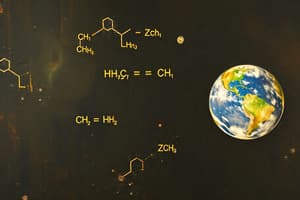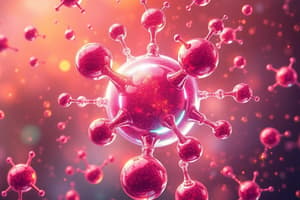Podcast
Questions and Answers
Which of the following is not a diatomic molecule?
Which of the following is not a diatomic molecule?
- H<sub>2</sub>
- CO<sub>2</sub> (correct)
- O<sub>2</sub>
- N<sub>2</sub>
A balanced chemical equation shows the reactants and products with equal numbers of each element on both sides.
A balanced chemical equation shows the reactants and products with equal numbers of each element on both sides.
True (A)
What prefix is used to denote three atoms in a molecular compound?
What prefix is used to denote three atoms in a molecular compound?
tri
A cation is formed when an atom ___ electrons.
A cation is formed when an atom ___ electrons.
Match the type of reaction to its correct equation format:
Match the type of reaction to its correct equation format:
Which of the following is a polyatomic ion?
Which of the following is a polyatomic ion?
The angle of reflection is equal to the angle of incidence.
The angle of reflection is equal to the angle of incidence.
What type of mirror is curved inwards?
What type of mirror is curved inwards?
The charge of iron can be either ______ or ______.
The charge of iron can be either ______ or ______.
Match the terms with their definitions:
Match the terms with their definitions:
Which type of lens is shaped like an hourglass?
Which type of lens is shaped like an hourglass?
A convex mirror curves inwards.
A convex mirror curves inwards.
What is the term used for a point where light rays converge?
What is the term used for a point where light rays converge?
What type of mirror produces a virtual image that is upright and smaller in size?
What type of mirror produces a virtual image that is upright and smaller in size?
The index of refraction for water is 1.00.
The index of refraction for water is 1.00.
What type of lens is used to correct myopia?
What type of lens is used to correct myopia?
Hyperopia is caused by the distance between lens and retina being too ______.
Hyperopia is caused by the distance between lens and retina being too ______.
Match the types of mirrors with their characteristics:
Match the types of mirrors with their characteristics:
Which phenomenon describes the bending of light as it passes from one medium to another?
Which phenomenon describes the bending of light as it passes from one medium to another?
Presbyopia can be corrected with bifocals.
Presbyopia can be corrected with bifocals.
What happens to light rays when they travel from a slow medium to a fast medium?
What happens to light rays when they travel from a slow medium to a fast medium?
What is the primary function of mitochondria?
What is the primary function of mitochondria?
Chloroplasts are found in animal cells.
Chloroplasts are found in animal cells.
What is the longest stage of the cell cycle?
What is the longest stage of the cell cycle?
The process of cell division is called _____
The process of cell division is called _____
In which phase do chromosomes line up along the equator of the cell?
In which phase do chromosomes line up along the equator of the cell?
Match the following cellular organelles with their primary functions:
Match the following cellular organelles with their primary functions:
The circulatory system is responsible for gas exchange in the body.
The circulatory system is responsible for gas exchange in the body.
What happens during cytokinesis?
What happens during cytokinesis?
What is the primary function of the alveoli in the respiratory system?
What is the primary function of the alveoli in the respiratory system?
The diaphragm is flat when exhaling.
The diaphragm is flat when exhaling.
Name one major organ of the digestive system.
Name one major organ of the digestive system.
The ________ is a tiny flap-like structure that prevents food from entering the respiratory system when swallowing.
The ________ is a tiny flap-like structure that prevents food from entering the respiratory system when swallowing.
Match the following body systems with their primary function:
Match the following body systems with their primary function:
Which of the following is a major source of methane gas?
Which of the following is a major source of methane gas?
The lithosphere refers to the water component of Earth's climate system.
The lithosphere refers to the water component of Earth's climate system.
Describe what is meant by 'anthropogenic' in relation to climate change.
Describe what is meant by 'anthropogenic' in relation to climate change.
Which of the following is NOT a greenhouse gas?
Which of the following is NOT a greenhouse gas?
The Law of Conservation of Mass states that matter cannot be created or destroyed in a chemical reaction.
The Law of Conservation of Mass states that matter cannot be created or destroyed in a chemical reaction.
Name one diatomic element.
Name one diatomic element.
In an ionic compound, the non-metal ends with the suffix __________.
In an ionic compound, the non-metal ends with the suffix __________.
Match the following terms with their correct descriptions:
Match the following terms with their correct descriptions:
What is the pH range for bases?
What is the pH range for bases?
The focal length of a concave lens is always negative.
The focal length of a concave lens is always negative.
What structure in plant cells is responsible for separating daughter cells during mitosis?
What structure in plant cells is responsible for separating daughter cells during mitosis?
Flashcards
Angle of Incidence
Angle of Incidence
The angle formed between the incident ray and the normal.
Normal
Normal
A line perpendicular to the surface of a mirror or lens at the point where the incident ray strikes.
Angle of Reflection
Angle of Reflection
The angle formed between the reflected ray and the normal.
Incident Ray
Incident Ray
Signup and view all the flashcards
Reflected Ray
Reflected Ray
Signup and view all the flashcards
Focus
Focus
Signup and view all the flashcards
Principal Axis
Principal Axis
Signup and view all the flashcards
Object
Object
Signup and view all the flashcards
What are Diatomic Molecules?
What are Diatomic Molecules?
Signup and view all the flashcards
What is a Chemical Formula?
What is a Chemical Formula?
Signup and view all the flashcards
How are Ionic Compounds Formed?
How are Ionic Compounds Formed?
Signup and view all the flashcards
How are Molecular Compounds Formed?
How are Molecular Compounds Formed?
Signup and view all the flashcards
What is a Chemical Reaction?
What is a Chemical Reaction?
Signup and view all the flashcards
Plane Mirror
Plane Mirror
Signup and view all the flashcards
Concave Mirror
Concave Mirror
Signup and view all the flashcards
Convex Mirror
Convex Mirror
Signup and view all the flashcards
Index of Refraction
Index of Refraction
Signup and view all the flashcards
Hyperopia (Farsightedness)
Hyperopia (Farsightedness)
Signup and view all the flashcards
Presbyopia
Presbyopia
Signup and view all the flashcards
Myopia (Nearsightedness)
Myopia (Nearsightedness)
Signup and view all the flashcards
Refraction
Refraction
Signup and view all the flashcards
Mitochondria
Mitochondria
Signup and view all the flashcards
Nucleus
Nucleus
Signup and view all the flashcards
Cell Wall
Cell Wall
Signup and view all the flashcards
Cell Membrane
Cell Membrane
Signup and view all the flashcards
Cytoplasm
Cytoplasm
Signup and view all the flashcards
Vacuole
Vacuole
Signup and view all the flashcards
Chloroplast
Chloroplast
Signup and view all the flashcards
Interphase
Interphase
Signup and view all the flashcards
What is the Law of Conservation of Mass?
What is the Law of Conservation of Mass?
Signup and view all the flashcards
What are diatomic elements?
What are diatomic elements?
Signup and view all the flashcards
What are alveoli?
What are alveoli?
Signup and view all the flashcards
What is gas exchange?
What is gas exchange?
Signup and view all the flashcards
What is the epiglottis?
What is the epiglottis?
Signup and view all the flashcards
What is the trachea?
What is the trachea?
Signup and view all the flashcards
What is the diaphragm?
What is the diaphragm?
Signup and view all the flashcards
What is the heart?
What is the heart?
Signup and view all the flashcards
What are arteries?
What are arteries?
Signup and view all the flashcards
What are veins?
What are veins?
Signup and view all the flashcards
Study Notes
Chemistry
- Diatomic Molecules: H₂, O₂, F₂, Br₂, I₂, N₂, Cl₂
- Chemical Formulas & Naming: Chemical formulas represent reactants and products in equations. Word equations can be converted to skeleton equations then balanced. Ionic compounds are formed by combining a metal and a non-metal. Molecular compounds consist of two non-metals. Prefixes (mono, di, tri, etc.) are used to specify the number of atoms of each element when naming molecular compounds.
- Types of Reactions:
- Synthesis: A + B → AB
- Decomposition: AB → A + B
- Single Displacement: A + BC → B + AC
- Double Displacement: AB + CD → AD + CB
- Neutralization: acid + base → salt + water
- Combustion: CxHy + O₂ → CO₂ + H₂O
- Cations & Anions: Cations are positive ions formed by losing electrons, while anions are negative ions formed by gaining electrons.
- Polyatomic Ions: Examples include nitrate (NO₃⁻), chlorate (ClO₃⁻), carbonate (CO₃²⁻), sulfate (SO₄²⁻), phosphate (PO₄³⁻), hydroxide (OH⁻), and ammonium (NH₄⁺).
Optics
- Terms:
- Angle of incidence: angle between incident ray and normal
- Angle of reflection: angle between reflected ray and normal
- Normal: dashed line perpendicular to the surface.
- Incident ray: incoming light ray
- Reflected ray: outgoing light ray
- Focus: converging point for light rays from object.
- Principal axis: Line passing perpendicular to the centre of curvature.
- Object: item in real life determining image formation
- Image: copy of the object
- Specular reflection: smooth surfaces
- Diffuse reflection: rough surfaces
- Types of Mirrors/Lenses:
- Plane mirror : Flat
- Concave mirror: curved inward
- Convex mirror: curved outward
- Converging lens: almond shaped
- Diverging lens: hourglass shaped
- Rules for diagrams: Rules for drawing ray diagrams for plane, concave, and convex mirrors and converging and diverging lenses are important.
- SALT: Same, upright, same distance, virtual (mirror characteristics)
Biology
- Cell Division: Cells divide to reproduce, grow, and repair.
- Cellular Organelles:
- Mitochondria: cellular respiration (energy production)
- Nucleus: control center, contains DNA
- Cell wall: support and protection (plants only)
- Cell membrane: selectively permeable barrier
- Cytoplasm: holds organelles
- Vacuoles: storage
- Chloroplasts: photosynthesis (plants only)
- Cell Cycle: Interphase (growth), Mitosis, Cytokinesis
- Systems Interaction: The digestive, circulatory, and respiratory systems work together. The digestive system breaks down food and delivers nutrients to the circulatory system, which circulates them through the body. The respiratory system delivers oxygen required by the circulatory system for the body's functions and removes carbon dioxide, a byproduct.
- Types of Tissue: Epithelial, connective, muscle, and nervous tissues.
Climate Change
- Components of Earth's Climate System: Atmosphere, Hydrosphere, Cryosphere, Lithosphere, Biosphere
- Greenhouse Gases: Water vapor, carbon dioxide, methane, nitrous oxides, ozone, chlorofluorocarbons (CFCs)
- Sources of greenhouse gases: Often related to human activity. Examples: livestock, landfills.
- Anthropogenic Impacts on Climate Change: Human activities produce greenhouse gases which affect Earth's climate by trapping heat.
Studying That Suits You
Use AI to generate personalized quizzes and flashcards to suit your learning preferences.




